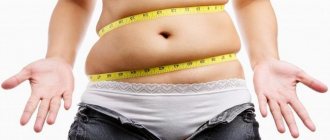Basal metabolism (basic metabolism, basic metabolism) – what is it?
We can say that these three concepts are synonyms, but still there are some differences in their definition.
Basal metabolic rate is the amount of energy you need just to live without straining, for example, lying on the couch and watching TV, or sitting in a chair. At the same time, you are not physically or mentally active. That is, this is the minimum energy that you need.
Basic metabolism or basic metabolism is the amount of energy (kilocalories) that your body burns under the same circumstances - lying on the bed or sitting in a chair without straining your brain or getting physically tired.
These terms imply the minimum individual amount of energy (daily calories) necessary for the normal functioning of all human organs in the process of metabolism, emotional and psychological peace. The state of rest also requires a certain amount of energy to maintain temperature, breathing, secretions, the functioning of the responsible nerve centers of the brain, and for good blood circulation. Today we will calculate the basal metabolic rate for women and men of all ages.
Main conclusions
- A starvation diet is enemy number 1.
- It is better to use calorie indicators accepted in official medicine as a basis.
- The amount of energy for basal metabolism, no matter what formula it is calculated by, cannot be underestimated.
- The table must be balanced according to the used/f/u ratio.
For those who are scared, unclear, difficult or lazy - contact my “Active Weight Loss Course” . Everything that is said there was experienced by the author in his own skin, and with health benefits. You will lose weight immediately and irrevocably!
That's all for today. Thank you for reading my post to the end. Share this article with your friends. Subscribe to my blog. And let's move on!
Factors that determine the dependence of daily human energy expenditure
These include body weight, lifestyle, gender, diet, age. Consequently, depending on this, one person differs from another in that his minimum energy expenditure is greater than that of another. They can be the same age, do the same things, but differ in body structure and other characteristics. Therefore, daily caloric intake varies.
Bioimpedance: what, why and why?
Well, let's start, as usual, with the background, or rather, coverage of the work that was done earlier. Let it be known to you that with this article we are completing the cycle of sports-medical notes, because we have discussed all the previously discussed topics, and these include [Sports ointments], [How to train with sore joints?] and [Tests for an athlete]. If you are still clueless, then we strongly recommend that you familiarize yourself with these writer’s masterpieces :), but we will go further and today we will analyze a procedural topic - bioimpedance.
It's no secret that people come to the gym primarily to change their physique. However, for many, the indicator in important matters is the usual scales and the deviation of the arrow on them in one direction or another. So, for example, young ladies immediately after 40 minutes of group jumping run to the scales and, seeing the arrow there creeping to the left, they think that they have lost weight (the fat mass has gone away). On the contrary, the male gender, noticing the deviation of the scale arrow to the right, states that muscle mass has begun to gain. Both the first and second are wrong, because the arrow on the scale is not a direct indicator of changes in the quality of the physique. At the everyday level, it is more correct to pay attention to such parameters as:
- anthropometry – body measurements taken on an ongoing basis once every 2 weeks;
- reflection in the mirror – visually real changes in the figure;
- clothing markers - began to “fit better” into their old things.
However, the everyday level is a primitive level, and it does not give a complete picture to a person of his internal-external changes and state of health in general. Therefore, a potential bodybuilder or athlete who has decided to seriously take on changing their figure should pay attention to more modern methods of analyzing body composition, for example, the bioimpedance method (BIA). This is what we will talk about in more detail later in the text.
Note: For better assimilation of the material, all further narration will be divided into subchapters.
Bioimpedance: main features
Bioimpedance is a diagnostic method that allows, based on measured values of electrical resistance and anthropometric data, to estimate the absolute and relative values of body composition parameters, as well as the body’s capabilities and the risks of developing certain diseases.
The main audience includes people who want to achieve an ideal (in their opinion) figure, for example, girls who want to properly lose weight without tissue dehydration and damage to muscle mass, or who want to gain muscle mass with a minimum amount of fat.
The main capabilities of BIA include measurements:
- fat mass;
- body mass index;
- percentage of body fat;
- amount of muscle tissue;
- percentage of active cell mass;
- quantity and distribution of fluid in the body;
- basal metabolic rate;
- waist to hip ratio;
- biological age.
How is the procedure itself carried out and how does the method work?
The human body is a chain of resistances and capacitors. The BIA method is based on the assumption that fat is a conditional insulator (does not conduct/poorly conducts current due to its lipid composition), since it does not contain water (values of the order of 5-10 %), and the conductor is the fat-free mass. Due to the large amount of water contained in muscles (up to 75% ), they are a good conductor (fat-free mass will have less resistance to electric current). The faster the signal travels, the more muscles a person has.
Thus, the electrical signal travels quickly through water, which is present in hydrated muscle tissue, but encounters resistance when it hits fat tissue. This resistance is called impedance.
Electrical conductivity is affected by the ratio of ions, the condition of bone tissue and other important processes in the body.
Note:
The ability of tissues to transmit electric current is associated with a high concentration of water in the body and electrolytes dissolved in it.
The bioimpedance procedure itself consists of placing electrodes on certain parts of the body (lower leg and forearm) and passing a small ( 50 kHz) alternating current through them. Sensitive sensors record the required indicators, and the computer produces the finished result.
Based on impedance measurement data, the athlete will be able to determine whether his current combination of training program and nutrition plan is working and in which direction he is moving in relation to his goals.
Pros and cons of BIA
If you are going to carry out this procedure, then know that it has both advantages and disadvantages. The first include:
- accuracy of results (error up to 5%);
- speed of implementation (on average 10-15 minutes);
- painlessness (no current is felt);
- accessibility – carried out in any “mid-range” fitness center;
- relatively low price for the procedure ( 700-1000 rubles) or free if you have a club membership (annual subscription).
Disadvantages of BIA include:
- gender bias. Men and women store fat around the belly and thighs differently, so results (a measure of overall body fat percentage) may be less accurate;
- the amount of fluid consumed before the procedure. Electricity passes more easily through water. A person who drinks a lot of water before the procedure will have lower body fat percentages. Decreasing the amount of water will increase your body fat percentage. Therefore, for the accuracy of the results, it is better not to eat/drink 1.5-2
- The timing of the procedure can also contribute to the final results, so it is better to carry out the analysis at the same time of day, namely before breakfast, before training or 1.5-2 hours after drinking/eating.
We've covered some theoretical points and now let's get down to...
Bioimpedance: practical side. Learning to read and understand data.
Let's assume that you completed the BIA procedure yourself and received the results. However, the printouts themselves do not mean anything; you need to be able to interpret them correctly in order to understand what “internal” changes are happening to you (how your body composition changes). And the following guide to parametric decoding will help us figure this out.
No. I. Descriptive models of human body composition
, 2 or 4 parametric models are most often used
- 2-component: 1) fat, 2) fat-free mass;
- 4-component: 1) muscle mass/protein (protein), 2) total body water (TBW) = inside + extracellular fluid (Intracellular/Extracellular), 3) bone mineral mass (bone mineral), 4) fat mass (fat ).
The basic 2- component model considers only fat mass and fat-free mass. This model is widely used in hydrodensitometry and anthropometric measurements and has its limitations. Multivariable models take into account other parameters in addition to fat and lean mass. With the help of such models, it is possible to study the composition of a person’s body more “deeply” and provide more complete/detailed recommendations regarding maintaining a person’s health (including changes in physique through a training program and diet).
No. II. Basic parameters of human body composition
Everyone who has undergone the bioimpedance procedure receives a printout with the results of the analysis. What does literally each line mean? We will talk about this further and start with...
No. 1. Body Mass Index (BMI/BMI)
BMI = weight (kg)/H*H (sq.m.) – an indicator for approximate assessment of the degree of obesity (correspondence to body weight and height of a person).
The following normalized BMI values exist.
Key findings on BMI:
- BMI is directly affected by body type and bone thickness;
- the same BMI value (depending on the presence/conditionally absence of muscle mass) can correspond to both a rather voluminous/dense and a toned athletic figure;
- In ectomorphs, BMI usually has low values (less than 18,50).
No. 2. Fat mass (FM)
The mass of human adipose tissue, which is represented by two components: 1) main/essential fat and 2) stored fat. Fat serves as an energy source for the body (supports human functionality), and is also responsible for reproductive functions and acts as a “nerve winding” (myelin sheath).
Key findings on FM:
- depending on gender, age and race, the percentage of fat can be different (in women it is 10-12% more than in men);
- with age (especially after 40 ), the percentage of visceral fat (around organs) increases and muscle mass decreases;
- Average normal values of fat mass for ordinary people are: for men - 18-20% , women - 25-27% ;
- non-professional/non-performing female athletes should not pursue a low percentage of fat (“hard to dry”/values of 10-12% ) and, as a consequence, a high percentage of muscle mass, because this threatens hormonal shifts and disruption of the reproductive process;
- the percentage of adipose tissue determines whether a person has health problems and excess weight (whether he is obese);
- an arrow to the left on the scale while dieting does not mean a reduction in the percentage of adipose tissue; it is possible that a person has lost weight due to muscles.
No. 3. Fat free mass /lean mass
Lean muscle mass (LBM) is the total amount of fat-free (lean) part of the body, which consists of water, protein, minerals and ash. The LBM is mainly represented by bones, muscles, proteins, tendons and tissues of all internal organs.
Key findings on FFM/LBM:
- changes (increase in parameter) indicate a gain in lean muscle mass;
- Peak values are reached at the age: for men 25-30 , for women 30-35. After passing these age milestones, lean muscle mass decreases;
- It is most beneficial for the development of large muscles to start exercising as early as adolescence ( 15-16 years old), in order to subsequently achieve your peak volumes in a relatively short time;
- muscle cells burn more calories ( 30 kcal/kg) versus fat cells ( 6 kcal/kg), so by increasing lean muscle mass, you will reduce the percentage of fat tissue;
- normal percentage of pure muscle mass: for men 75-85% , for women 65-75% ;
- body types/ectomorph/rectangle body types do not necessarily have low lean mass values. This is determined by bone mass (the person himself is thin, but has heavy bones);
- Nutritionists use lean mass to calculate the consumed energy component of the diet. The nutritional structure of people with different levels of lean body mass will be different.
No. 4. Active cell mass/ACM fraction
It includes the following structures: nerve cells, muscle and organ cells, intracellular fluid.
Main conclusions on AKM:
- in the process of losing weight, it is important for a person to lose fat mass and, at a minimum, maintain the same level of AFM;
- normal AKM% values for men are over 53% , for women – over 50% ;
- As the athlete becomes more trained (his performance capacity increases), the proportion of ACM increases.
No. 5. Muscle mass/musculoskeletal mass (SMM)
SMM is the portion of lean mass that consists of muscle and is considered an important indicator of overall physical strength. The skeletal muscle mass consists of aqueous (liquid/water up to 75% ) and non-aqueous (actin/myosin proteins) parts. It depends on the level of physical fitness and the diet that a person follows.
In the human body, it is customary to distinguish 3 types of muscle tissue: 1) skeletal (voluntary) - for performing skeletal movements, 2) smooth muscles - located in the walls of organs/structures (esophagus, stomach), 3) cardiac muscle.
Key conclusions on SMM:
- average values for men/women are 42/36% of body weight;
- during training, your body weight may increase, but these may be qualitative changes - an increase in muscle mass (muscle is denser than fat) and a decrease in fat mass;
- The more SMM a person has, the greater the amount of work (muscle loading capacity) he can carry out/perform during a workout.
No. 6. Basic exchange/specific basic exchange (BM/SBM)
Basal metabolism is the minimum energy expenditure (kcal) necessary to maintain the life of the body in a state of complete rest ( 12 hours after eating). Specific OO determines the intensity of metabolism (metabolism) and is calculated as the ratio of basal metabolism to body surface area (which depends on height/weight).
Main conclusions on OO/UOO:
- The more ACM, the more energy is spent on metabolism (ME), blood circulation and other vital functions. An increase in ABM/acceleration of metabolism (may be associated with the development of fitness) can contribute to a person’s weight loss;
- normal values of OO for men are 1500-1800 kcal, for women 1300-1500 kcal;
- after 30 years, OO decreases every year, which means making adjustments to your diet (reducing energy components, cutting fats/carbohydrates).
No. 7. Total body water (TBW)
TBW is the total body water content. This parameter changes with age (a younger person has a higher percentage of TBW in the body than his older counterpart). In early (adolescent) age, the content of total water in the body can reach up to 80-83% (in the elderly/after 60 years, up to 55-45% ).
The formula TBW = ICW + ECW means that total body water represents intracellular and extracellular fluids combined.
No. 7.1. Extracellular water (ECW)
Fluid found outside the cells of the body. It consists of:
- blood plasma;
- lymph;
- intercellular fluid;
- transcellular fluid (cerebrospinal, intraocular, abdominal, pleura, pericardium, joint capsules, synovial and gastrointestinal tract).
The amount of extracellular water is 40-45% of TBW.
No. 7.2. Intracellular water (ICW)
All fluids found inside the cells and tissues of the body. The amount of intracellular water is 20-25% of TBW.
Key findings on TBW:
- in tissues with a high water content, as a rule, a greater intensity of metabolic processes is noted and vice versa; Therefore, to lose weight you should be hydrated (drink enough water per day);
- In men, the water content in the body is slightly higher than in women (on average by 10% ), so men, in theory, are able to lose weight easier/faster;
- The more a person weighs (at the same gender), the more water there is in his body and vice versa.
No. 8. Waist/hip circumference & waist/hip ratio ( WHR index)
An indicator that contributes to determining a person’s figure/build type, based on anthropometric data (measurements). Changing the parameter upward or downward allows you to judge the effectiveness/ineffectiveness of the training program + nutrition plan combination.
Key findings on anthropometry:
- normal waist circumference values for active women of normal build (up to 30 years old) are 60-70 cm, for men (up to 30 years old) – 70-85 cm;
- a waist-to-hip ratio in women from 0.6 to 0.72 indicates an ideally proportioned figure;
- WHR index values of 0.85 for women and men indicate abdominal-visceral obesity.
No. 9. Classification by percentage of fat mass
A value scale that shows which “fat category” a person belongs to. Values from 20 to 30% are normative.
No. 10. Phase angle
It is considered as an indicator of the body’s fitness and endurance, as well as the degree of metabolic intensity. The value of the phase angle determines biological age (the correspondence of physical parameters to actual age).
Main conclusions regarding phase angle:
- standardized values are: below 4.4 - low, in the range 4.4-5.4 - low, above 5.4 - normal, above 7.8 - very high;
- indicators of 5.5 and above indicate the good condition of cell membranes, as well as a high percentage and activity of skeletal muscles and are most often recorded in athletic people in good health;
- with age, the phase angle values decrease;
- the higher the phase angle, the lower the biological age of a person;
- In ectomorphs (thin body type), the phase angle may have low values.
So, we have theoretically analyzed the main parameters of the composition of the human body, now let’s get down to it...
Indicators affecting metabolism
Each person has his own meaning of SBI due to the complex of above-mentioned differences. Let's consider the factors that have a great influence on the parameters of the basal metabolism:
- Weight. With a large body weight, a person becomes quite large, so he needs more energy;
- Height. Is of great importance in calculating SBI;
- Body. If a large amount of muscle is present, the metabolism will be faster or vice versa, obese people tend to have a slow metabolism, and lean (thin) people cannot gain weight due to their super-fast metabolism. Your metabolic rate is also affected by your body type, which is determined genetically. We have already written articles about body types in women and body types in men, read it, you will be interested;
- Age. The larger it is, the slower the OO becomes. For example, teenagers have a very fast metabolism, because the body is being built, the body is developing, hormones are playing, and this requires a lot of energy. In adults, everything has already been built, nothing develops, much less plays anything, therefore, fewer calories are needed;
- Nutrition. A proper diet will speed up and improve metabolic processes. You should never start fasting right away. This will not make you lose weight, but will only seriously harm your health;
- Lifestyle. Basic metabolism will accelerate with any physical activity within reasonable limits, which will only be beneficial. It will proceed much more slowly in a person if he does not find time for this, compared to someone who lives actively;
- Floor. Men's rates are much higher than those of the fair sex. After all, by nature, the stronger sex has more muscles than women, and muscles need to be “fed” with energy.
Basal Metabolic Index
OUR READERS RECOMMEND!
Our readers successfully use Monastic tea to treat the thyroid gland. Seeing how popular this product is, we decided to bring it to your attention. Read more here...
Metabolism (metabolism) consists of two inextricably linked metabolic processes in the human body: catabolism and anabolism, which maintain homeostasis - the constancy of the internal environment.
Catabolism is an energy metabolism that occurs in three stages:
- 1. Preparatory - transformation of complex organic compounds supplied as part of food products into simpler ones: proteins are converted into amino acids, fats into fatty acids and glycerol, polysaccharides into monosaccharides, nucleic acids into nucleotides. These reactions occur in the gastrointestinal tract under the catalytic action of enzymes. The released energy is transformed into heat and dissipated. Further, the formed organic compounds undergo oxidation or participate in the synthesis of substances necessary for the body.
- 2. Oxygen-free (incomplete oxidation) - characterized by further breakdown of organic substances without the participation of oxygen. The main source of energy in the cell is glucose. The process of oxygen-free oxidation of glucose is called glycolysis.
- 3. Respiration (complete oxidation) - step-by-step oxidative reactions involving oxygen, leading to the formation of carbon dioxide and water.
Anabolism (assimilation) is a process that includes reactions that convert simple compounds obtained as a result of catabolism into complex organic substances.
The energy released during catabolism is necessary for assimilation, which ensures the formation of enzymes. The latter serve as a catalyst for chemical reactions occurring during catabolism.
The energy released during the decomposition reaction of organic substances is not immediately used by the cell, but is stored in the form of the compound ATP (adenosine triphosphate).
The cellular supply of ATP is replenished during respiration.
The biology of metabolism is controlled by regulatory mechanisms: nervous and hormonal, affecting the synthesis of enzymes directly or by changing the permeability of cell membranes towards an increase.
Calculation of metabolic rate
For each person, the biochemistry of metabolic processes is individual. Metabolic rate reflects the required number of calories for the body to function and depends on the following factors:
- gender;
- age;
- physique;
- growth;
- genes.
A person's activity during the day regulates the rate at which calories are burned.
The basal metabolic rate—the number of calories needed per day—is calculated as follows:
Let's calculate the basic metabolic index of a 40-year-old man weighing 92 kg with minimal physical activity
DCI = (92x10+180x6.25–40x5+5)x1.2= 2220
Calculation of BMI (body mass index) is performed as follows:
Normally it should be less than 25 units. Higher rates indicate obesity.
For our example, the body mass index will be:
BMI=92/1.8x1.8=28.3
Metabolism is significantly influenced by the hormonal balance and psycho-emotional state of a person. If the thyroid gland does not produce enough thyroxine to support carbohydrate metabolism, this disorder reduces the use of calories obtained from food, storing excess weight in body fat.
Metabolic processes in children have a higher speed than in adults. This ensures the growth of the developing organism. Over time, metabolic processes slow down due to physiology.
And the older the person, the more pronounced the slowdown.
Calculation of the basal or metabolic age indicator, reflecting the age at which the body's metabolism corresponds, is performed using the Katch McArdle formula:
The level of body fat is measured by the size of the skin fold and determines the body type:
The measurement is performed with a caliper and a measuring tape.
An example of calculating the actual metabolic rate taking into account the percentage of fat in body weight (this can be determined using a calculator on sports sites - for this you will need to enter data on the size of the skin folds of different parts of the body). Let's say fat in our example is 10.5% of body weight:
- 1. Calculation of fat mass: 92 x 0.105 = 9.6 (kg).
- 2. Determination of fat-free mass: LBM = 92-9.6 = 82.4 (kg).
- 3. Calculation of basic calorie expenditure: BMR = 370 + (21.6 X 82.4) = 2149 (kcal).
Comparison of the results obtained with age-specific calorie consumption norms:
Analysis of the results of the obtained indicators helps to determine the basal age.
A decrease in basal calorie expenditure is typical for older people over 60 years of age.
Fat deposits in the area of the gastrointestinal tract and liver, located not in the subcutaneous layer, but around the internal organs, are called visceral fat. They significantly reduce your metabolic rate.
If the mass index is too high, then you are overweight. But if the general physique is thin, this indicates the presence of visceral fat.
A basal age higher than the actual age requires adjustment of the diet towards reducing its calorie content, and physical activity towards increasing it in order to ensure an acceleration of metabolism.
Increase Metabolic Rate
Physical activity of any kind: strength training, heavy physical activity helps build muscle mass. A large amount of muscle tissue requires more energy expenditure even at rest, increasing the rate of metabolic processes.
Aerobic breathing (the scientific name for cardio training) Bodyflex, performed every day for 15 minutes, will help significantly speed up your metabolism.
A balanced diet that avoids hunger and overeating will have a beneficial effect on the speed of metabolic processes. During the digestion of food, metabolism accelerates, so it is better to eat more often, in small portions.
Metabolic disorders
Disturbances in metabolic processes result from disruptions in the functioning of the following organs:
- adrenal glands;
- thyroid gland;
- gonads;
- pituitary gland
Poor or excess nutrition has a negative effect on metabolic processes in the body. In this case, a failure occurs in the regulation of metabolism by the nervous system: the tone of the hypothalamus, which regulates the rate of energy exchange, changes, and storage and construction processes are disrupted.
With lipid metabolism disorders, fats cease to be broken down normally in the liver, which leads to an increase in the concentration of low-density lipoproteins in the blood. Vascular damage occurs, causing stroke and heart disease.
Treatment and prevention of metabolic disorders
Normalization of nutrition is an important factor in the treatment and prevention of metabolic disorders in the body.
Foods that provide fast metabolism:
- protein food;
- hot spices;
- green tea;
- coffee;
- iodine-rich foods: seafood, seaweed.
Metabolic speed is also increased by dietary supplements containing:
- linoleic acid;
- coenzyme Q10;
- iodine;
- ephedrine;
- L-carnitine;
- creatine;
- caffeine
You can improve your condition and reduce the risk of developing diseases if you follow these rules:
- 1. Limit the consumption of animal fat.
- 2. Reduce caloric intake.
- 3. Avoid foods with a high glycemic index: fast food, sweets.
- 4. Regularly consume omega-3 fatty acids contained in the following foods: olive oil, walnuts, sea fish.
- 5. Practice periodic exercise that builds muscle mass and reduces fat accumulation.
- 6. Provide conditions for prolonged deep sleep, which ensures the production of growth hormone in the body.
Formula for calculating the level of basic basal metabolism in the human body
The basic metabolic rate represents a certain amount of energy that is expended by the human body when it is at rest.
In simpler terms, we are talking about the number of calories that the body needs in a minimal state so that it can simply exist. If the metabolic process is slow, then the energy in the body is spent in small quantities, which means a large accumulation of calories.
You also need to take into account that the basic metabolic index may be different for all people, since each person has his own individual characteristics.
Why do you need to know your basal metabolic rate?
Of course, it is clear that a person needs a certain amount of calories to maintain a normal state.
However, each person is individual, how can one find out exactly how many calories each person needs so that the body functions normally, there is no danger of excess weight, and there is no shortage of calories? In order to calculate the basic metabolism of basic substances, simple calculations should be made.
However, the first step is to multiply your basal rate by your activity level. And in order to lose weight, you just need to consume calories less than the value that was obtained from such calculations. To calculate basal metabolic rate, basal metabolic rate, you need to use different formulas, but they are all relative.
There are certain nuances - doctors do not recommend in all cases consuming less than 1800 calories every day for representatives of the stronger sex and less than 1200 for the fair sex.
In addition to reducing calorie levels, it is imperative to pay serious attention to regular physical exercise. Only together can the desired result be achieved.
Before increasing physical activity, you need to find out how much food you can eat beforehand; this is very important for basal metabolism.
OUR READERS RECOMMEND!
Our readers successfully use Monastic tea to treat the thyroid gland. Seeing how popular this product is, we decided to bring it to your attention. Read more here...
It should be noted that very different formulas can be used in this case (for example, there is the OOB formula), one of the most common can be cited as an example: PMR (this is the basic metabolism) = 6.5 * (9.6 + weight data) +(1.8*person’s height data)-(4.7*age indicators in years). For such a calculation, it is better to use a calculator; all this is calculated slowly. After this, the calculated amount can be used in the diet.
What factors need to be taken into account when calculating
Before making calculations, you need to consider certain factors:
- the older a person gets, the faster his muscle mass decreases, which means his metabolism slows down;
- tall people have higher performance;
- people with high muscle content have a high metabolic rate, but those who have fat instead of muscles have slower rates;
- when a person’s temperature rises, their metabolic rate also rises;
- calories are spent faster in people who are susceptible to stressful situations and illnesses;
- if the weather is very hot or, on the contrary, too cold, then calories are consumed faster;
- if a person is hungry, malnourished or fasting, then material metabolism slows down;
- certain organs have a direct effect on metabolism, and it can be positive or negative;
- people who smoke use up energy faster;
- people who drink a lot of coffee also use up energy quickly;
- A person spends the fewest calories when he sleeps.
You need to understand that for normal basic metabolism you need to eat healthy food and exercise. Then your metabolic rate will be normal.
Once again, it should be said that calculating the basal metabolic rate should not be a panacea, since many factors are important for the basal metabolic rate. Moreover, to count calories, one must take into account not only the quantity of food eaten, but also its quality. The speed of chemical reactions often depends on this.
Source: https://1shchitovidka.ru/shhitovidnaya-zheleza/bazovyj-indeks-metabolizma/
How to determine basal metabolic rate
Basal metabolic rate is calculated using a special method called calorimetry. BOO is determined by a special camera that records metabolic processes in the body. Such a measurement is labor-intensive, so you can use an analogue that does calculations using gas exchange. To determine the elements subject to oxidation (fats, proteins, carbohydrates), the respiratory coefficient is calculated, which is the ratio of released carbon dioxide and absorbed oxygen. This coefficient has completely different meanings for the oxidation of carbohydrates, fats or proteins.
Rubner's surface rule
This law is that all energy expenditures of each warm-blooded individual are directly dependent on the surface of the body. That is, per square meter of body area the amount of heat is dissipated equally under standard conditions. Therefore, volume and mass have a direct effect on basal metabolic rate. In other words, the smaller you are, the fewer calories you need, and vice versa.
Rules for calculating basal metabolic rate
You can calculate your basal metabolic rate yourself. For this, several formulas are used that were invented more than a century ago. There are also many sites dedicated to a healthy lifestyle, which have an online calculator that allows you to quickly calculate the indicators of BOO suitable for normal life activities. To do this, you will need to enter the required values in the specified fields. But before that, use the formulas below and then compare the results.
Using total body weight, you can calculate your basal metabolic rate using the Harris-Benedict formula, the original version of which was invented back in 1919. In 1884, with adjustments for the modern way of life, it was significantly modified, so the result of the calculations will be more accurate.
Just plug in the numbers you need into the equations:
- How to calculate OO for men: P = (13.397 * weight, kg) + (4.799 * height, cm) – (5.677 * age) + 88.362;
- How to calculate basal metabolic rate for women: P = (9.247 * weight, kg) + (3.098 * height, cm) – (4.330 * age) + 447.593.
Where P is the heat produced by an organism at complete rest.
There is another basal metabolic rate formula based on total body weight - Mifflin-St. It is slightly more accurate than the previous one.
As an example, let's take a 55-year-old woman with a height of 168 cm and a weight of 59 kg. As a result, her BOO will be 1204 kcal.
But these equations have an inaccuracy - they do not include indicators of metabolic activity taking into account the amount of fat in the body. It turns out that if you choose two men with exactly the same height, weight and age, the results will be absolutely identical. In reality, their basal metabolic rate will be significantly different due to the fact that the first man is “fat” and the second is “jocked.”
For such cases, the Katch-McArd equation is used:
P = 370 + (21.6*LBM), where LBM is mass excluding fat. For example, with a weight of 70 kg, of which 30% is the fat component (it will be equal to 21 kg), the muscle component will be equal to 49 kg (70-21). When substituting this value into the formula, we get a result of 1428 kcal.
Thus, the basal metabolic rate can vary significantly among people with almost the same parameters. The indicators are also influenced by many other external and internal factors.
Calculator and table
If you are completely confused about calculating your basic metabolism, then to obtain more accurate and comprehensive information, it is better to contact a specialist who will tell you how many calories you need daily in order to be in an alert state and not gain extra pounds.
Each person’s body has individual characteristics, but there is a table of average values of basal metabolism that can be used by everyone. It indicates the minimum number of calories per day that a person requires, taking into account his basic parametric data.
Calculation of the basic metabolic index
The basic metabolic index represents the necessary energy expenditure for the work of all cells of the body at rest: the mechanical work of the heart, liver, kidneys, lungs, brain, and digestive system.
Metabolism is an metabolic process that begins with the entry of food into the body. Then the nutrients are broken down and the necessary energy is released. There are two types of metabolism - basic and activity-specific.
Advice from the chief parasitologist...
Pinworms, Giardia, tapeworm, helminths, tapeworm...
The list goes on for a long time, but how long are you going to tolerate parasites in your body? But parasites are the main cause of most diseases, from skin problems to cancer. But the head of the Institute of Parasitology of the Russian Federation, German Shaevich Gandelman, assures that it is easy to cleanse your body even at home, you just need to drink...
Read more "
The calculation of basal metabolism is approximately 1 kilocalorie per 1 kilogram of weight per 1 hour. The metabolic process starts 12 hours after eating food.
In order to find out the general level of exchange, you need to use a special formula.
In one and the same person, metabolism in different conditions can differ by 10% and depends on the state of health, ambient temperature, and type of activity.
What is basal metabolism?
Basal metabolism is based on the minimum consumption of kilocalories that are needed for the life of the body itself without the influence of external factors. Even when a person sleeps, energy reserves are used for the functioning of internal organs and the chemical processes occurring in them.
Metabolism
The metabolic rate depends on height, weight, age, gender, and the quantitative ratio of muscle and fat tissue. With age, the brain, liver, and muscle volume decrease in size, respectively, fewer calories are spent on metabolism. After age 50, there is generally a 7% decrease in caloric needs every 10 years.
Metabolism occurs faster in muscle tissue than in fat tissue. With the accumulation of extra pounds, there is a chance of gaining even more weight if you do not change your lifestyle.
The female body has less muscle and more fat reserves than the male body; accordingly, women need fewer kilocalories for metabolic processes.
The main energy expenditure requires the consumption of nutrients not below the norm; excessive food restriction is perceived by the body as starvation. The automatic process of fat storage is immediately activated, which leads to rapid weight gain after the diet.
About dry fasting Sergei Ivanovich Filonov
What does metabolic rate depend on?
In addition to the basic level of metabolism, in the natural process of which it is better not to interfere, there is a metabolism that depends on the type of activity. In this area, a person can and even must regulate the ratio of nutrition and energy consumption. Both unjustified food consumption and depletion of the body by insufficient amounts of food should not be allowed.
Metabolism
In this case, the metabolic rate is already influenced by eating habits and general attitude towards life. If a person perceives food as a reward, a way to relax, to escape from problems, then in 80 cases out of 100 excess weight is already present. The process is aggravated by the lack of desire to play sports, lead an active lifestyle, and go for walks.
Depending on the type of activity, you need to not only count calories, but also choose the foods from which these calories come. Meat dishes take longer to digest than others, which means the body needs more energy to process them.
Porridge, bread, potatoes, flour, and sweets are digested much faster, which does not require large energy costs. The energy released from digestive processes must be spent on active physical activity.
It is this ability of the body that athletes of active sports use: runners, skiers, cyclists, speed skaters, using up glycogen reserves during training and competitions.
But in the life of an ordinary person, the opposite picture can be observed: cakes are eaten in the evening in front of the TV, and then sleep immediately follows. While a person rests, unused carbohydrate calories gradually turn into fat deposits.
In order for your metabolism level to correspond to the norm, you need to follow the basic rule of nutrition - eat as much as you are going to use.
In addition, additional factors influence metabolic rate. It increases during:
- too high or low ambient temperature;
- active mental or physical activity;
- stressful situation.
Is it possible to eat seeds if you have high cholesterol?
The rate decreases during dieting, fasting, low activity, sleep or hormonal imbalance.
How to correctly calculate the required amount of calories?
Scientists have worked for many years to develop special formulas that would help calculate the correct ratio of calorie intake and energy expenditure. There are several such formulas, but none of them reflects 100% the situation of each individual person.
The basal metabolic rate can be calculated as follows:
RMR = 655 + (9.6 x weight) + (1.8 x height) - (4.7 x age in years).
For example, weight – 80 kg, height – 175 cm, age – 30 years.
RMR = 655 + (9.6 x 80) + (1.8 x 175) - (4.7 x 30) = 1597 (kcal).
This is approximately how many kilocalories a person spends at rest. This formula does not take into account gender.
We multiply the activity coefficient by the resulting result. With an ordinary sedentary lifestyle, it will be equal to 1.2; with training from 1 to 3 times a week - 1.375; from 3 to 5 times a week – 1.55; 6 or 7 times a week – 1.725.
For example: 1597 x 1.2 = 1916.4 (kcal).
Calorie calculation
This is an indicator of the total acceptable number of calories that a sedentary person can afford in one day, without harm to the body and accumulation of excess fat.
How to improve metabolism in the body?
If the metabolism was disturbed for some reason, then regulating the metabolic level to a normal state can take a very long time and even years. Often you cannot do without the help of specialists.
Here are some tips on how to properly maintain your metabolism:
- do not go on diets or starve without medical indications;
- do not use hormonal drugs unless absolutely necessary;
- maintain the ratio of calories in and out.
About ways to normalize cholesterol levels
If a person decides to lose weight, then he needs to divide 3 meals a day into 5 or 6 times to reduce the volume of the stomach. You can consume no more than 250–270 ml of food or water at a time.
It is also necessary to increase physical activity, at least do exercises every day. After a year, your metabolic rate will increase by 40% per 1 kg of weight.
There is no need to try to lose weight through grueling fasting, because the body is only able to give up 3 kg of fat in 1 month, the rest is water and muscle.
Those who want to gain weight or at least not lose even more weight should under no circumstances skip their prescribed meals. Force yourself to eat at a certain time, even if you don’t feel like it. It is advisable to increase the number of meals at least once.
People who have reached their desired weight should continue to lead a healthy lifestyle, exercise, and monitor the quality and quantity of food they eat.
Since all exchange processes are unstable and depend on many factors, you need to build your regime in accordance with the circumstances.
on this topic:
Source: https://shlakov.net/organizm/raschet-bazovogo-indeksa-metabolizma.html
Increase in basal metabolism
To lose weight and gain a slim, beautiful figure or simply switch to a healthy lifestyle, you need to increase your OO indicators. For this:
- Play sports. Such activities burn a lot of calories;
- Drink more water (about three liters per day). It really helps you lose weight, but watch the quality of your drink;
- Eat healthy foods that need to be taken according to the schedule. At the same time, metabolic processes will certainly increase. If you want to lose weight, your calorie intake should be reduced. But don’t “overdo it” with this, because a constant feeling of hunger is also bad;
- Get a massage. Cellular metabolism will “launch its mechanisms” at a different level, and all this will have a great effect on increasing OO;
- Your thoughts should only be positive. This also has a beneficial effect on basic metabolism, because due to bad thoughts and stress, the hormone cortisol is released, and it floods with water, this does not have a very good effect on the figure;
- Regulate your sleep. Give yourself enough rest;
- Go to the bathhouse more often. Visiting the sauna will only benefit your health; in addition, you get rid of excess water in the body;
- Walk more in the fresh air. This will have a positive effect on the functioning of all your organs and your condition in general.
In one of our articles, we wrote in detail about how to speed up your metabolism. Ask questions and leave comments under the article.
HOW MUCH ENERGY DO YOU NEED TO KEEP LIVING?
Are you on a weight loss mission and want to know what is the least amount of calories you need to stay alive, then this BMR calculator is the tool you need?
The BMR calculator or Basal Metabolic Rate calculator calculates the number of calories your body needs to function properly. If you want to know what my BMR is, you need to calculate your BMR using this BMR calculator. BMR depends on the muscle mass you have in your body. If you are more muscular, your BMR will be higher than someone who is simply fat but doesn't have good muscles. And your muscles need energy to keep working and if your body is not getting the least amount of energy, it will weaken your muscles and you will start to feel tired and sluggish.
Physical activity
This is the most variable component, responsible for 10-30% of the calories you burn each day and is directly related to the mobility of your lifestyle.
Since we have already figured out the calculation of metabolism, now all you have to do is find out your physical activity quotient in order to calculate how much energy you spend daily.
Again, according to British scientists who sifted through a mountain of literature on the topic of energy expenditure, the following numbers best reflect the different levels of physical activity of the population:
- 1,49 – sedentary lifestyle (for example, sedentary work without exercise);
- 1,63 – an average active lifestyle (for example, sedentary work (or one that does not require serious physical activity) + irregular sports or regular but light-intensity training;
- 1,78 – a more active lifestyle - energy-intensive work or regular training of medium-high intensity 3-5 times a week;
- > 2 – a very active lifestyle, which is usually observed among professional athletes and soldiers during preparation for combat missions.
Example
So, our average Masha works in an office, sometimes runs in the park and goes to yoga, so we multiply her basal metabolism of 1253 kcal by a factor of 1.63 and get 2042 kcal - approximately this amount of energy in general Masha spends daily.
As for losing weight, nutritionists advise losing weight by no more than 0.5 kg per week by reducing energy intake by 500 kcal per day. In Masha’s case, this means a safe, but rather meager diet of 1540 kcal, so in her case it is better to increase energy expenditure through sports.
It is noteworthy that in order to lead a more active lifestyle with a coefficient of 1.78, Masha only needs to walk half an hour longer a day at an average pace.
Basal metabolic rate or metabolism
This is the number of kilocalories spent by the body to maintain vital functions at rest. Basal metabolism is responsible for 60-70% of daily energy expenditure.
To calculate your basal metabolic rate, select the weight, height, and constant values for your gender and age from the table below and use them in the following equation:
Weight factor x weight (kg) + height factor x height (m) + constant
| Floor | Age | Basal Metabolism | ||
| Weight factor | Growth rate | Constant | ||
| Male | < 3 | 28.2 | 859 | -371 |
| 3-10 | 15.1 | 313 | 306 | |
| 10-18 | 15.6 | 266 | 299 | |
| 18-30 | 14.4 | 313 | 113 | |
| 30-60 | 11.4 | 541 | -137 | |
| >60 | 11.4 | 541 | -256 | |
| Female | < 3 | 30.4 | 703 | -287 |
| 3-10 | 15.9 | 210 | 349 | |
| 10-18 | 9.4 | 249 | 462 | |
| 18-30 | 10.4 | 615 | -282 | |
| 30-60 | 8.18 | 502 | -11.6 | |
| >60 | 8.52 | 421 | 10.7 | |
For example, 25-year-old Masha, who weighs 50 kg and is 1.65 cm tall, needs 1253 kcal to maintain the normal functioning of her body.
10.4 x 50 kg + 615 x 1.65 m – 282 = 1252.75 kcal
How to calculate BMR using Basic Metabolism Calculator?
This basal metabolic rate calculator is designed for non-experts so that anyone can use it easily. No technical skills or BMR formula required here. All you have to do is enter basic numbers such as your age, gender, your weight and your daily activity level and calculate your BMR by clicking or tapping on the calculate button. When you enter information, please be assured that the information you provide to us when calculating your BMR is never stored anywhere and will not be used for any other purpose. This information is used only to calculate your BMR, and when you leave the page or site, this information is no longer used.











